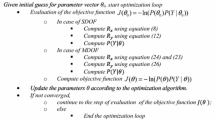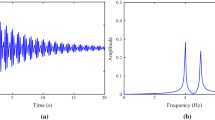Abstract
An accurate prediction for the response of civil and mechanical engineering structures subject to ambient excitation requires the information of dynamic properties of these structures including natural frequencies, damping ratios and mode shapes. Since the excitation force is not available as a measured signal, we need to develop techniques which are capable of accurately extracting the modal parameters from output-only data. This article presents the results of modal parameter identification using two time-domain methods as follows: the autoregressive moving average vector (ARMAV) method and the state–space method. These methods directly work with the recorded time signals and allow the analysis of structures where only the output is measured, while the input is unmeasured and unknown. The equivalence between ARMAV and state–space approaches for the problem of modal parameter identification of vibrating systems is shown in the article. Using only the singular value decomposition of a block Hankel matrix of sample covariances, it is shown that these two approaches give identical modal parameters in the case where the block Hankel matrix has full row rank. The time-domain modal identification algorithms have a serious problem of model order determination: when extracting structural modes these algorithms always generate spurious modes. A modal indicator to differentiate spurious and structural modes is presented. Numerical and experimental examples are given to show the effectiveness of the ARMAV or state–space approaches in modal parameter identification using response data only.
Similar content being viewed by others
References
Ljung L.: System Identification-Theory for the User. Prentice-Hall, Englewood Cliffs (1987)
Juang J.N.: Applied System Identification. Prentice-Hall, Englewood Cliffs (1994)
Pandit S.M., Wu S.M.: Time Series and System Analysis with Applications. Wiley, New York (1983)
Pandit S.M.: Modal and Spectrum Analysis: Data Dependent Systems in State Space. Wiley, New York (1991)
Harris C.M.: Shock and Vibration Handbook. Mc-Graw Hill, New York (1996)
Papagiannopoulos G.A., Beskos D.E.: On a modal damping identification model of building structures. Arch. Appl. Mech. 76, 443–463 (2006)
Kompalka S.A., Reese S., Bruhns O.T.: Experimental investigation of damage evolution by data-driven stochastic subspace identification and iterative finite element model updating. Arch. Appl. Mech. 77, 559–573 (2007)
Lardies J.: State space identification of vibrating systems from multi output measurements. Mech. Syst. Signal Process 12, 543–558 (1998)
Van Overschee P., De Moor B.: Subspace identification for linear systems: theory implementation and applications. Kluwer, Dordrecht (1996)
Pi Y.L., Mickleborough N.C.: Modal identification of a vibrating structure in the time-domain. Comput. Struct. 32, 1105–1115 (1989)
Lardiès J., Ta M.N., Berthillier M.: Modal parameter estimation based on the wavelet transform of output data. Arch. Appl. Mech. 73, 718–733 (2004)
Ruzzene M., Fasana A., Garibaldi L., Piombo B.: Natural frequencies and damping identification using the wavelet transform: application to real data. Mech. Syst. Signal Process 11, 207–218 (1997)
Ibrahim S.R.: Random decrement technique for modal identification structures. J. Spacecr. Rockets 14, 696–700 (1977)
Petsounis K.A., Fassois S.D.: Parametric time-domain methods for the identification of vibrating structures-critical comparison and assessment. Mech. Syst. Signal Process 15, 1031–1060 (2001)
Zhang Y., Zhang Z., Xu X., Hua H.: Modal parameter identification using response data only. J. Sound Vib. 282, 367–380 (2005)
Peeters B., De Roeck G.: Stochastic system identification for operational modal analysis: a review. J. Dyn. Syst. Meas. Control 123, 659–667 (2001)
Hermans L., Van Der Auweraer H.: Modal testing of structures under operational conditions: industrial applications. Mech. Syst. and Signal Process 13, 193–216 (1999)
Mevel L., Basseville M., Goursat M.: Stochastic subspace-based structural identification and damage detection—application to the steel quake benchmark. Mech. Syst. Signal Process 17, 91–101 (2003)
Huang C.S.: Structural identification from ambient vibration measurements using the multivariate AR model. J. Sound Vib. 241, 337–359 (2001)
Garibaldi L., Giorcelli E., : ARMAV techniques for traffic excited bridges. J. Vib. Acoust. 120, 713–718 (1998)
Pi Y.L., Mickleborough N.C.: Modal identification of vibrating structures using ARMA model. J. Eng. Mech. 115, 2232–2250 (1989)
Lenzen A., Walter H.: Damage detection by system identification. An application of the generalized singular value decomposition. Arch. Appl. Mech. 66, 555–568 (1996)
Aoki M.: State Space Modeling of Time Series. Springer, Berlin (1990)
Viberg M.: Subspace-based methods for the identification of linear-time invariant systems. Automatica 31, 1835–1851 (1995)
Rao S.: Mechanical Vibrations. Addison-Wesley, Reading (1995)
Barbieri N., Honorato de Souza Junior O., Barbieri R.: Dynamical analysis of transmission line cables. Linear Theory. Mech. Syst. Signal Process 15, 1031–1060 (2001)
Ren, W.X., Chen, G.: Experimental modal analysis of stay cables in cable-stayed bridges. In: Proceedings of the 21th IMAC, Kissimmee, Florida (2003)
Author information
Authors and Affiliations
Corresponding author
Rights and permissions
About this article
Cite this article
Lardies, J. Modal parameter identification based on ARMAV and state–space approaches. Arch Appl Mech 80, 335–352 (2010). https://doi.org/10.1007/s00419-009-0322-1
Received:
Accepted:
Published:
Issue Date:
DOI: https://doi.org/10.1007/s00419-009-0322-1




